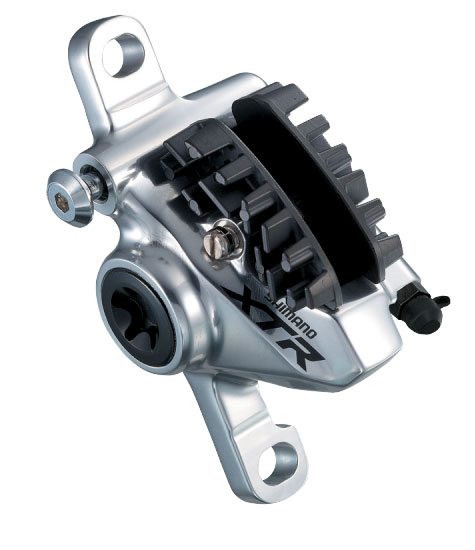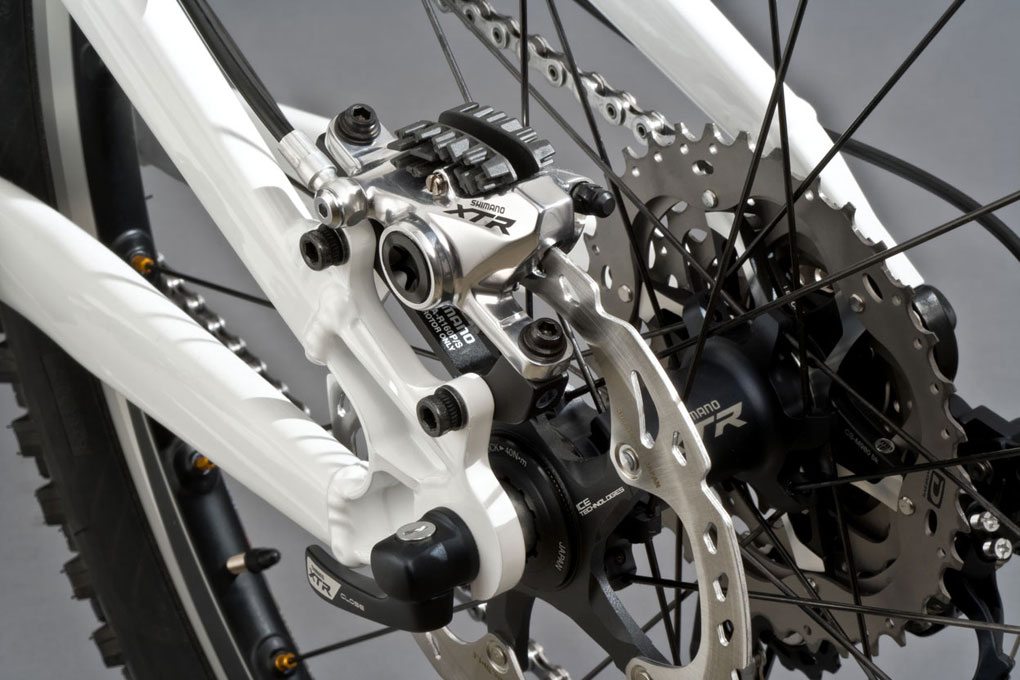Component: Shimano XTR Trail Brake
(BR-988 Lever, BR-985-FIN Caliper, RT-75XT Rotor)
Weights:
Lever: Average 196g (pair);
Caliper: Average 220g (F&R Resin pad/Ice-tech);
Rotor: Average 203g (not tested in this review)
Intended Use: Trail and All-Mountain Riding
Rider: 5’11″, 165 lbs., 32″ inseam. Charge hard on the uphill and downhill. Prefer steep, techy climbs that test line choice and bike handling ability and similar downhills with some buff, drifty corners in the mix.
Test Locations: Crested Butte, Grand Junction, Monarch Crest
Duration: One season
Brakes, to me, used to be a pretty unexciting bike component—until I realized that the right brake really helps me ride faster and more aggressively. I discovered this downhilling, when in 2007 a new set of Avid Codes increased my ability level tremendously. I found I could lay off the levers, confident that my brakes had the power to take care of most speed adjustments—or a complete stop—at the drop of a hat. My riding became faster, more fluid and committed, and I realized that brakes were a key item to riding fast.
These were downhill brakes, of course, with 203mm rotors to avoid excessive heat, and four-piston calipers providing power to spare. Such specs come with a weight penalty, however, which made putting a brake like that on a trailbike a little much. So in past years I have tried other, lighter offerings (Hayes Strokers and Avid Elixirs) and found plenty of stopping power—but a good degree of fading when things got hot after extended braking.
Shimano set out to address this fading with the introduction of their new XTR Trail Brakes, and after using the XTR on my all-mountain rig for the past season, riding everything from all-day adventure rides with huge descents to lift-served crushing, I’d have to say Shimano pretty well nailed it.

At the core of the XTR’s performance are the heat dissipating technologies introduced in this product. Foremost are the industry-first, full-ceramic piston and radiator-backed pads. Shimano also offers optional “Ice-Technology Radiator” pads, which, from my experience, are well worth it. The pads look pretty gimmicky, with a large fin protruding out of the top with, well, a radiator, but they really seem to do the trick. This is all housed beautifully in a polished, one-piece forged-aluminum body. Coupled with a polished aluminum and matte black lever unit, it’s a beautiful piece of bling to add to your build.
The XTR also brings some new tricks to the table with its shorter lever (pictured on the next page), which is designed for one-finger braking and coupled with Shimano’s Servo-Wave technology. Shimano claims this delivers quicker engagement, improved pad-retraction, and the ability to “precisely control 25 percent more power.”
A lack of availability in parts from Shimano prevented me from setting up the brakes last summer with the IceTech two-piece, aluminum-core rotor, which is supposed to round out the cooling system. Instead I used Shimano’s standard 6-bolt XT rotors, 160mm in the rear and 180mm in the front, but have still experienced no heat problems, even on the longest descents and lift-served DH runs. Paired with a seemingly indefinite, freshly bled feel, I received no surprises from these brakes (the component from which I least like surprises).


Yes, the XTs are pretty much the same and less pricey. Personally IMHO these are the best AM/DH brakes out there especially (as reviewer points out) when paired with IceTech rotors and winged metal pads. The hydro brakes hardly if ever need any adjustment as long as you bleed them a once or twice a year and keep the fluid topped off, which is very simple and easy for anyone. The bottom line: These brakes are virtually bombproof and will make anyone a better rider.